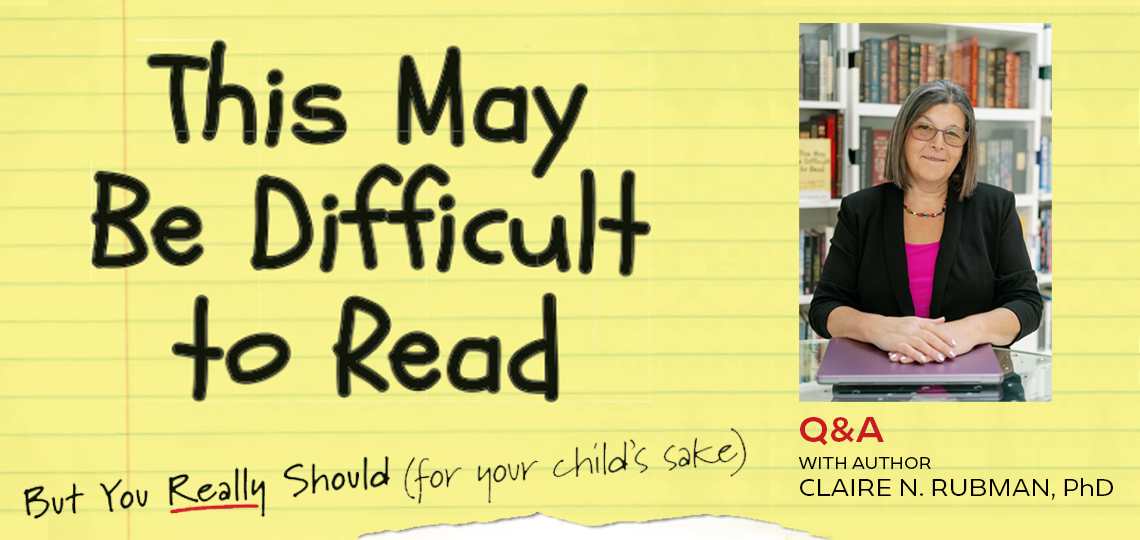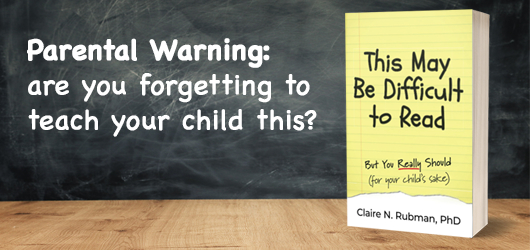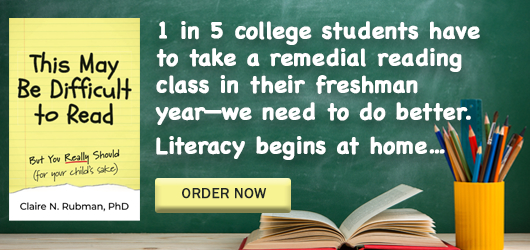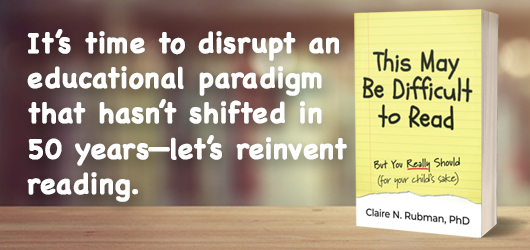What can we do at home to help our children to succeed?

Reviewer Michele Sharpe Interviews Claire N. Rubman, Author of This May Be Difficult to Read: But You Really Should (for your child’s sake)
Reid, reed, read. Each of those words mean something different, of course, but to a three or four year old sounding out the letters—simply decoding the letters into sounds—that meaning is almost certainly lost on their little brains.
So, what does it mean to read? If the purpose of reading is to acquire information and understanding, why do we teach it in a way that prioritizes pronunciation over comprehension? Might that question explain why the majority of high school students need a remedial reading class?
Claire Rubman imagines a better way. The author of This May Be Difficult to Read, Claire would like us to acknowledge the fact that a four year old brain doesn’t have the neurological skill to extract meaning from written text. She believes, and ample amounts of research shows, the fifty year experiment in teaching phonics at home and in schools has been a failure.
We were intrigued by Michele Sharpe’s glowing Clarion review of This May Be Difficult to Read, so we connected her with Claire to talk more about how to reinvent reading.
Is the drive to teach children to read at increasingly younger ages a feature of United States culture, or is it a worldwide phenomenon? Either way, do you have any thoughts about why the phenomenon is with us?
Parents have the best intentions for their children, they want them to succeed. Many parents work extremely hard to provide their children with every possible advantage and opportunity in life. After all, it’s the American Dream to give the next generation even more. This includes their child’s early childhood education.
Parents teach their children shapes, colors, letter, and sounds. Many teach their children to say the words on a page out loud before their child ever steps foot in a kindergarten classroom. Many parents believe that they are giving their child an educational boost or “jump start.” Unfortunately, some parents may not necessarily realize that there is so much more to reading than just “saying the words aloud” or “decoding.” Children have to learn how to extract meaning from the printed word, or “comprehend” what they read to avoid the literacy failure chain in middle school, high school, or college. No parent expects their child to fail but, sadly, many do—the numbers don’t lie:
-
70% of high school student take some type of remedial reading class
-
In the last 15 years, 15 million students have graduated from our high schools reading below the “basic” reading level
-
1 in every 5 college students has to take a remedial reading class in their freshman year
-
42,000,000 American adults can’t follow the directions on a can of soup.
Conscientious parenting isn’t addressing our nation’s reading dilemma. This is possible due, in part, to the fact that parents are missing vital steps in the reading process. This remains a hidden problem as the failure chain may not show until middle school, high school, or college. Parents read fluently and effortlessly. Many have forgotten how much cognitive strain the reading process puts on a child’s developing brain. This May Be Difficult to Read gives parents the opportunity to think as a child thinks by engaging in activities that simulate what novice readers face when they try to comprehend.
This May Be Difficult to Read also offers parents a blueprint for success by detailing how to create a “need to read” in the home. Learn how to transform your home into an ideal ecosystem where learning is a byproduct of fun! This May Be Difficult to Read offers parents a 4-stage reading program that they can incorporate into their frenetic lifestyle with little additional effort. I focus primarily on American parents and children so I wouldn’t like to speculate about other cultures.
You mention that children don’t think, speak, or learn like their parents do. Can you summarize some important differences in the ways children and adults learn?
Yes, Jean Piaget (1896-1980) really taught us so much about how children think, learn, and process information. Although he did a great deal of his work in the 1950s, modern technology such as MRIs and PET scans serve to validate his findings.
In short, children are egocentric and have limited processing skills. They think from their own perspective. They lack the worldly experience and processing capacity that adults have at their fingertips. Children have limited neural networks, or “schemas” as Piaget called them. Whatever we call them, these are essential for making sense of the world around us.
What does this mean for parents? Parents have to try to think as a child thinks and learn as a child learns. Here are 3 suggestions:
-
Don’t “tell” children facts. Facts sit in splendid isolation in a child’s brain. Instead, allow your child to discover and “learn” for himself, herself, or themselves. In this way, new knowledge will be added to existing knowledge to deepen a child’s understanding.
-
Create an environment in your home where children can explore, using “hands-on” manipulation of the environment. In other words, children learn best by actively “doing” rather than watching or listening.
-
Be a role model for your child so that your child can emulate your behaviors. Whilst this may sound contradictory since I just said that children don’t learn by “watching,” Albert Bandura’s (1925-2021) concept of “observational learning” suggests that children do copy behaviors that they see. If children see their grown-ups reading, debating, talking, visiting museums, etc., then the power of observational learning suggests that they may try these activities. The converse is also true; if children see their grown-ups playing video games, texting, and watching tv, then …
You distinguish between rote repetition and deep comprehension, arguing that comprehension is the higher form of learning. Is there ever a place for rote learning in a child’s education?
Look, it depends on your educational goals. If you want children to repeat information, then sure, rote repetition is great! If you actually want children to think, learn and process information that they can then reuse in other contexts, then no, there is no place for rote repetition in a child’s education.
Words, concepts, and theories that are repeated but not comprehended at a deeper level will remain superficial for a child. A child may be able to repeat Pythagoras’ theorem or Einstein’s theory of relativity but what use is that if there is no deeper underlying conceptualization? If our children are to be the next generation of inventors, revolutionaries, and leaders then we ought to teach them to think for themselves!
How can parents of young children distinguish between decoding and comprehension when observing their children read?
Parents should never be “observing” their children as they read. Parents should actively participate in the reading process regardless of their child’s age:
-
Parents of pre-readers should read vociferously with their child and associate books with every possible event in their child’s life.
-
Parents of emergent readers should continue to read to and “with” their child, discussing analyzing, linking, and predicting the story content at every possible opportunity.
-
Parents of decoders/readers should continue to read with their child, discuss themes and storylines, anticipate actions, and explore motives to enhance a child’s reading experience and deepen comprehension skills.
Reading should be an active and shared experience that promotes conversation and exploration. All reading should involve comprehension, as reading devoid of meaning is tantamount to saying meaningless words aloud—a pointless task.
Can you explain the role of “automaticity” in reading and why children are at a disadvantage in this area?
As adults, we read effortlessly or “automatically.” Sometimes it’s easy to forget how hard it was in the beginning to learn those letters and sounds! When children first approach reading, letters do not automatically have a sound associated with them. It takes time to learn that the letter “B” makes a “Bih” sound. This is phonics. And we know that phonics can’t and doesn’t work!
Of course, we know that there are twenty-six letters in the English language, but we also know that there are forty-five phonemes or sounds. Because there is no “one-to-one” correlation between letters and sounds, phonics doesn’t and can’t work. Vowels are the problem child here: you know that there are 5 vowels, A, E, I, O and U. But did you know that there are eighteen different vowel sounds? In other words, “a” doesn’t always say “ay” as in “day,” sometimes it says “ah” as in “hat.”
Herein lies the problem. How do children know which vowel sound to attribute to which vowel letter? Again, we adults do this automatically, but for children, it takes time. Part of the issue here is that all that cognitive capacity that is being taken up with “sounding out the letters” could have been used for text comprehension or understanding what it is that we are actually reading.
How are children impacted in the classroom if their background knowledge, or context, differs from other children’s contexts? For example, children who’ve relocated to an area may not be familiar with local food customs. How can the classroom itself function as a common background for reading comprehension?
Background knowledge is essential for reading comprehension. Again, as adults, we often take this knowledge for granted. Let me give you an example from This May Be Difficult to Read that succinctly addresses this question of background knowledge. Read the passage below, then we can discuss it:
“Jim went to the restaurant and asked to be seated in the gallery. He was told that there would be a half hour wait. Forty minutes later the applause for his song indicated that he could proceed with the preparation. Twenty guests had ordered his favorite, a cheese souffle. Jim enjoyed the customers in the main dining room. After 2 hours, he ordered the house specialty—roast pheasant under glass. It was incredible to enjoy such exquisite cuisine and yet still have fifteen dollars. He would surely come back soon.” (Schank, R.C., & Abelson, R.P., 1975. Scripts, Plans and Knowledge. International Joint Conference on Artificial Intelligence.)
As you read, some things may have made sense to you; after all, who hasn’t had the experience of having to wait forty minutes for a table in a restaurant? Other aspects of this story may have become increasingly frustrating for you. What gallery? What song? What preparation? Why did Jim enjoy the customers in the main dining room? Why did he wait two hours, and so on.
The point here is that you tried to make sense of this story. Look how hard you worked! Shank and Abelson, who wrote this story, invented new rules for restaurant eating where the customer has to entertain all the guests and earn money to be able to prepare food. It sounds bizarre but their point (and mine) was to show you just how much background information you actually bring to a text and how hard you work to apply the knowledge that you have. Since children have limited experiences there are three points here:
-
Take children places and let them explore to develop their range of experiences.
-
With each experience that a child encounters, try to find a book that relates to it. This will allow children to apply their background knowledge to the story.
-
Making brief picture books with children to chronicle events will help them to learn to bring their background knowledge to a story. These books can be as simple as a walk in the park or as complex as a trip to a museum. They all convey the same message—bring your knowledge to the book!
You mention that standardized testing is “a cheap approximation of a child’s abilities.” How did our education system get stuck in the standardized testing trap, and how can K-12 education escape it?
Once again, we need to make a clear distinction between superficial knowledge and a deep understanding of a concept or issue. In our current educational system, are we testing a child’s ability to recite rote facts or are we assessing a deeper level of understanding? Whilst there is a need to “assess” within our school system, we should be transparent about what we are actually assessing. To avoid the standardized testing of rote facts, we should reassess the function and purpose of school. What do we want the 21st-century child to learn? What will give a child the best outlook in life beyond 12th grade? Coupled with this, school should be fun. It should be an exciting adventure that every child is eager to participate in and perform optimally within.
Instead, we actually have some school districts that have tried paying their students to attend class to incentivize them. What does that tell us about our current program? Perhaps it’s time to overhaul the entire K-12 educational system.
Your book has many interactive elements, and many illustrations. Why did you include these in a book for adults?
There are some brilliant research studies that allow us to think as a child thinks and read as a child reads. What better way to discuss our dysfunctional educational system than to let the reader experience these flaws “first hand.” Bringing the research to a parent’s living room is an ideal way to share the missing information that parents need if we are to address reading comprehension shortcomings in our children.
Once a parent experiences the missing aspects of reading comprehension, we can begin to address how to change what we teach our children. Missing components include limited background knowledge, failure to apply existing knowledge, an incorrect perspective, or the need for proposition integration. You’ll have to read the book to find out more about these concepts and how to address them in your home!
Michele Sharpe



